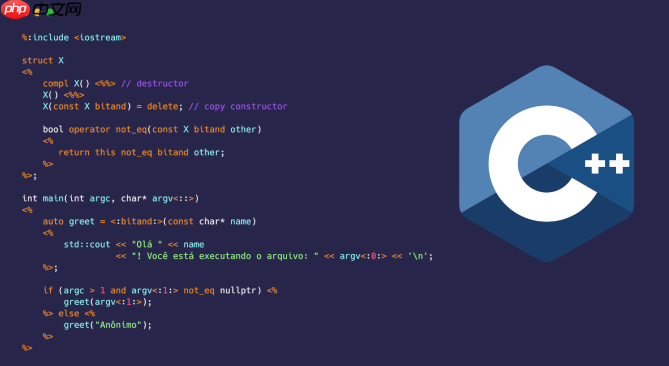c++++20的std::format库是一种类型安全、高效且现代的格式化解决方案。1. 它通过编译时检查格式字符串和参数类型,避免了运行时类型不匹配错误;2. 利用变参模板和编译时计算提升性能;3. 提供丰富的格式化选项,如精度控制、对齐方式和千位分隔符;4. 支持固定大小缓冲区格式化;5. 相比sprintf更安全、更快且可读性更强;6. 适用于c++20及以上版本,是传统格式化方法的首选替代方案。

C++20的std::format库提供了一种类型安全、高效且现代的方式来替代传统的sprintf。它不仅解决了sprintf的类型安全问题,还提供了更强大的格式化选项和更好的性能。

解决方案
std::format通过编译时检查格式字符串和参数类型,避免了运行时因类型不匹配而导致的错误。它还利用了现代C++的特性,如变参模板和编译时计算,实现了高性能的格式化。

基本用法:
立即学习“C++免费学习笔记(深入)”;
#include <format> #include <iostream> int main() { int age = 30; std::string name = "Alice"; double pi = 3.14159; // 使用 std::format 进行类型安全的格式化 std::string message = std::format("Hello, my name is {} and I am {} years old. Pi is {:.2f}.", name, age, pi); std::cout << message << std::endl; // 输出: Hello, my name is Alice and I am 30 years old. Pi is 3.14. return 0; }
sprintf的替代方案:

sprintf的一个主要问题是类型安全。例如,如果你传递了一个int但格式字符串期望的是char*,sprintf可能会导致程序崩溃或产生未定义的行为。std::format则会在编译时检查这些错误。
// sprintf 的例子 (不安全!) // char buffer[50]; // int age = 30; // sprintf(buffer, "I am %s years old", age); // 编译可以通过,但运行时会出错!
使用std::format:
#include <format> #include <iostream> int main() { int age = 30; std::string message = std::format("I am {} years old", age); // 编译时会报错,因为类型不匹配(假设想要格式化字符串到char数组) std::cout << message << std::endl; return 0; }
实际上,如果真的需要格式化到固定大小的char数组,可以这样:
#include <format> #include <iostream> #include <vector> int main() { int age = 30; std::vector<char> buffer(50); size_t written = std::format_to_n(buffer.data(), buffer.size(), "I am {} years old", age).size; buffer[written] = '�'; // 确保字符串以 null 结尾 std::cout << buffer.data() << std::endl; return 0; }
如何处理复杂的格式化需求?
std::format 提供了丰富的格式化选项,可以处理各种复杂的格式化需求。例如,你可以指定数字的精度、宽度、对齐方式等。
#include <format> #include <iostream> int main() { double value = 1234.5678; // 指定精度和宽度 std::string formatted_value = std::format("{:.2f}", value); // 输出: 1234.57 std::cout << formatted_value << std::endl; // 指定宽度和对齐方式 formatted_value = std::format("{:>10.2f}", value); // 输出: 1234.57 (右对齐,宽度为10) std::cout << formatted_value << std::endl; formatted_value = std::format("{:<10.2f}", value); // 输出: 1234.57 (左对齐,宽度为10) std::cout << formatted_value << std::endl; formatted_value = std::format("{:^10.2f}", value); // 输出: 1234.57 (居中对齐,宽度为10) std::cout << formatted_value << std::endl; // 使用千位分隔符 formatted_value = std::format("{:,.2f}", 1234567.89); // 输出: 1,234,567.89 std::cout << formatted_value << std::endl; return 0; }
std::format的性能如何?与sprintf相比有什么优势?
std::format通常比sprintf更快,因为它可以在编译时进行更多的优化。此外,std::format避免了运行时类型检查的开销,这进一步提高了性能。
std::format的优势:
- 类型安全: 编译时检查类型错误。
- 可读性: 格式字符串更易于阅读和维护。
- 性能: 通常比sprintf更快。
- 扩展性: 可以自定义格式化器。
sprintf的劣势:
- 类型不安全: 运行时可能出现类型错误。
- 可读性差: 格式字符串难以阅读和维护。
- 性能: 通常比std::format慢。
- 缺乏扩展性: 难以自定义格式化器。
总的来说,std::format是sprintf的更好替代品,它提供了类型安全、高性能和更好的可读性。在C++20及更高版本中,应该优先使用std::format。当然,如果项目还在使用旧版本的C++,可以考虑使用Boost.Format库,它提供了类似的功能。


















